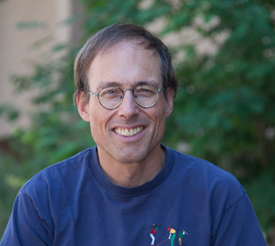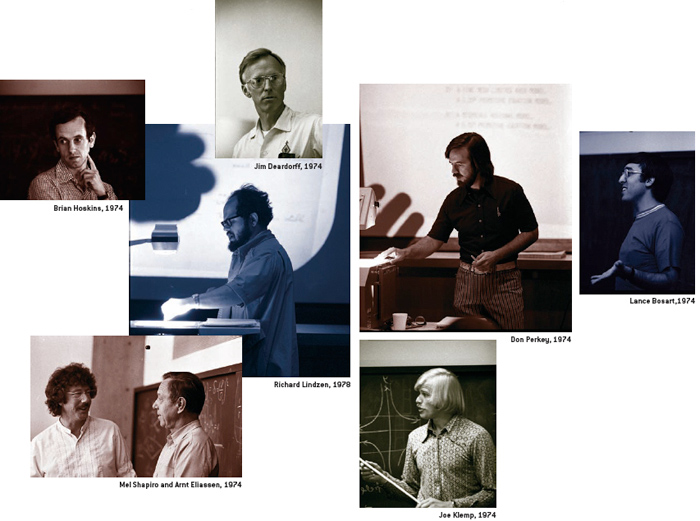The ASP Summer Colloquium: Past, present, and future
May 6, 2011 - by Staff
May 6, 2011 - by Staff
6 May 2011 • In the summer of 1966—when Gemini 10 was launched, the Vietnam War intensified, and England won the World Cup at Wembley Stadium—the NCAR Advanced Study Program conducted, under the direction of its founder, Philip Thompson, its first ASP Summer Colloquium. The topic was “Thermal Convection,” a subject that linked the fields of atmospheric dynamics, aeronomy, and stellar physics. Eighteen lecturers and 15 students, representing 22 universities, participated. Students took and revised notes on lectures and contributed summaries and brief written reports on their own research. The first summer colloquium ran for six weeks, from early July until mid-August. This allowed ample time for interactions between the lecturers and students and among the students themselves.

Chris Davis is director of the NCAR Advanced Study Program. (© UCAR. This image is freely available for media and nonprofit use.)
Including that first meeting, ASP has sponsored 46 summer colloquia in 45 years. Topics have ranged from solar physics to climate change to atmospheric measurements and more. Students have engaged in traditional lecture settings as well as experiences oriented around field work, such as in “CHON Photochemistry of the Troposphere” (1980), which examined carbon, hydrogen, oxygen, and nitrogen, and “Exploring the Atmosphere: Observational Instruments and Techniques” (2009), in which students designed a field campaign with airborne and ground-based components. Both individual and team research has taken place, with students often presenting preliminary results before they depart.
Many prominent researchers in atmospheric and related science have participated in the ASP colloquia as lecturers, students, or both over the years. Although photos are not available from every meeting, pictures from a few colloquia over the years (see photo montage at bottom) illustrate the small-group settings and generally relaxed atmosphere, as well as trendy clothing and hair styles.
Many aspects of the original colloquium continue today, including the approximate number of participants and the combination of lectures and discussions about students’ research. However, its length has decreased over time, due in part to budget pressures. In recent years, the colloquium has run for two weeks. Feedback from students attending recent ASP colloquia, while very positive, suggests that this is not enough time to complete independent research projects that offer valuable applications of some of the concepts learned in lectures. Students want more time not only to absorb the material but also to soak up NCAR, become acquainted with new colleagues, and interact with researchers. (In the early colloquia, there was often only one lecture per day, with ample time for lecture-note review and discussion.)
In response to these suggestions, ASP is extending the summer colloquium to three weeks beginning this year. It is a far cry from the six weeks of decades past, but it still represents a significant step given how many competing demands there are these days on everyone’s time.
Some colloquium lecturers have asked whether there might be an analogous opportunity for researchers to gather and talk about a particular topic in depth for an extended period of time. Scientific meetings and symposia are usually dominated by presentations with relatively little time for discussion among participants. Meetings have tended to grow in size, meaning long days and parallel sessions. Since many participants attend only part of a given meeting, it can be difficult to generate thought-provoking discussions among many leading researchers on a particular topic.
Rather than create a separate meeting, ASP has added a researcher colloquium (RC) as part of an expanded student colloquium, with the RC forming the middle of the three weeks. This will provide an opportunity for both experienced and early-career researchers to discuss particularly novel or vexing problems in a given area. The theme will be the same as for as the student portion of the colloquium, but focused largely on major questions and controversial issues.
While the RC format may vary from year to year, depending on how each organizing committee wishes to best utilize the week, we envision a mix of a few keynote lectures (open to all), panel discussions, breakout sessions, and free collaborative time for principals to discuss science issues in depth. Students participating in the colloquium will be encouraged to attend the RC; indeed, they would probably find it a rewarding extension of background material learned in the first week of the colloquium. A modest amount of time during the RC could also be set aside for students to meet with faculty participants one-on-one about their research.
The ASP intends to make the expanded colloquium a permanent event, although the format will change from year to year in its details. The total number of participants in a typical RC will probably be around 50 or so, with roughly half being students, a few others being lecturers from weeks one or three, and the rest being invited or selected through an application process.
Funding is always a concern, so ASP will seek partnerships to help support the colloquium expansion. This year we are teaming with the U.S. CLIVAR program (Climate Variability and Predictability). In other cases we may form internal collaborations, such as with the NCAR Integrated Science Program (ISP), which advances multidisciplinary and interdisciplinary research.
Our overall intent is to keep the ASP Summer Colloquium going strong and provide the next generation of researchers a motivational and memorable experience—plus a chance to use all the new forms of visual and social media to remember the best and worst hair and clothing styles from the early 21st century.

A Who's Who of atmospheric researchers has taken part in ASP colloquiua over the years, as illustrated with this sampling from the 1970s. (© UCAR. This image is freely available for media and nonprofit use.)